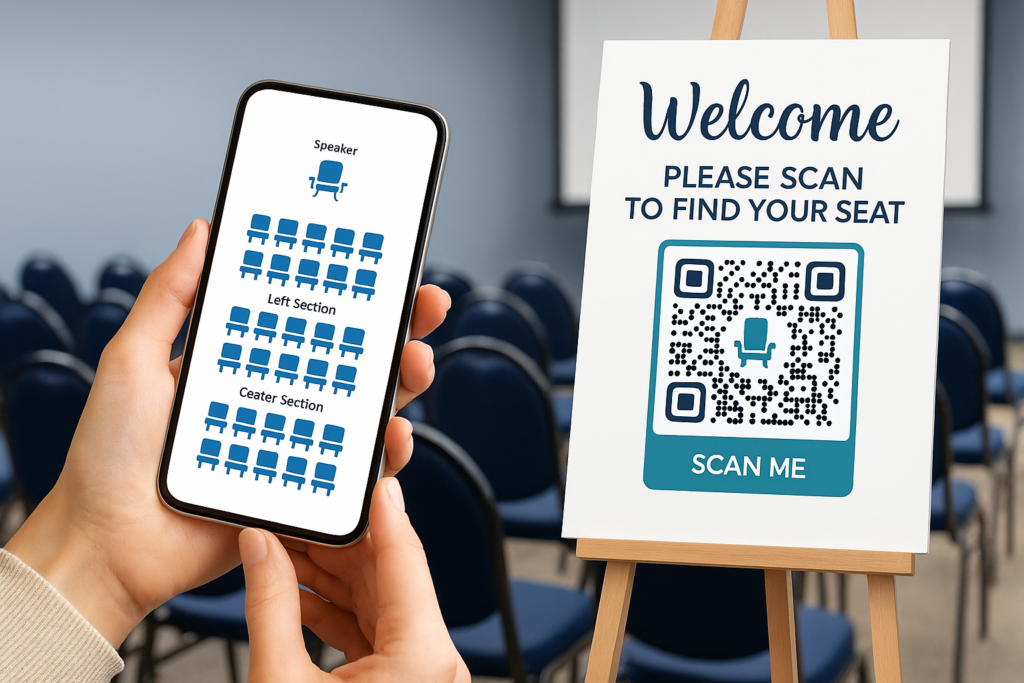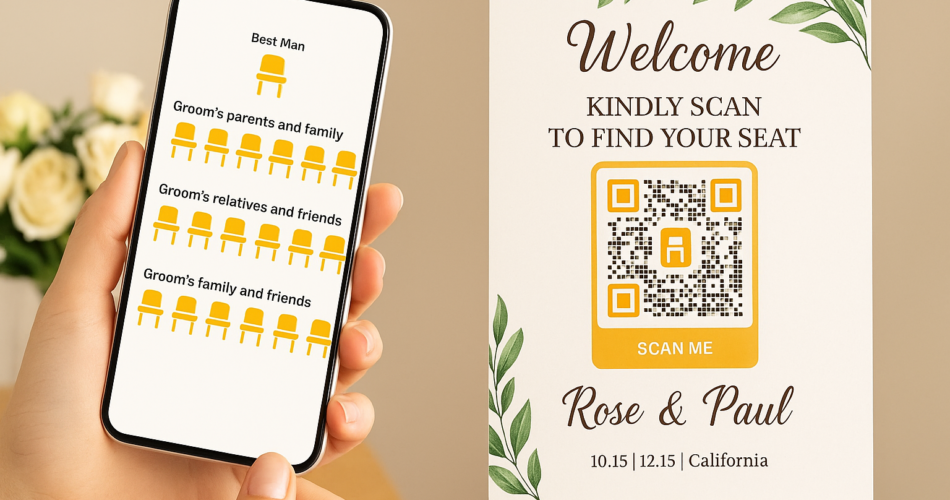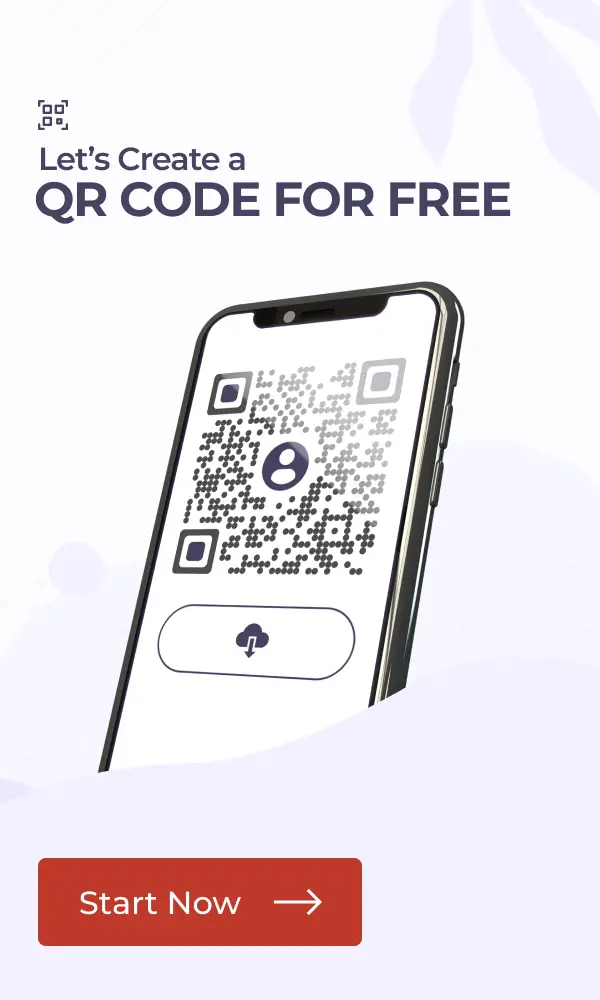Ask any event planner, and they’ll tell you that seating charts are one of the toughest parts of event planning.
Guest lists change, VIPs need rearranging, and a single misprint can throw off the flow of an entire evening.
Whether it’s a wedding with 200 guests, a gala dinner, or a corporate conference, seating charts are a logistical minefield.
It’s not just anecdotal. Event planners consistently rank seating management among the most complex tasks of the job. And when it goes wrong, guests notice.
As Caitlin Kuchemba of Clover Event Co. explains, a thoughtful seating chart “creates a luxury experience where guests feel like you’ve thought about them at every turn.” The opposite, a crowded board, outdated lists, or last-minute pen marks, creates the exact reverse impression.
This is where technology makes a real difference. QR Codes transform the way seating charts are shared and managed.
Instead of bottlenecks at a poster, guests scan a code on their phone and instantly see where to sit.
For organizers, it means no reprints, real-time updates, and a smoother event check-in experience.
And with QR adoption growing rapidly, the events industry alone accounts for nearly 8% of all QR Code scans, and guests already know what to do.
QR Code for seating charts turns a stressful task into a seamless guest experience.
A. Who should use QR Code for seating charts, and why it matters?
QR Code seating charts aren’t just a trendy add-on; they’re a polished, stress-relieving solution for anyone managing guest seating across events.
1. Event planners & venue managers
Why it matters: Seating arrangements are among the most complex and stressful components of event execution.
One misplacement can throw off guest flow, slow down service, or even create awkward situations during seating.
As Cassie LaMere, founder of Cassie LaMere Events, points out:
“When guests move seats, this significantly impacts the flow of service for the event… For guests with allergies and special diets, this is an extremely important responsibility for the event team.”
A QR Code seating chart streamlines that complexity, no crowding around a board, no pen scribbles, and far fewer errors.
2. Hosts & couples (weddings, social gatherings)
Why it’s relevant: Today’s weddings and social affairs balance personalization with efficiency. Guests appreciate seamless, tech-savvy touches. One guide notes that QR Codes reduce overwhelm and crowding:
Less than 5% of people said they didn’t know how to scan a QR Code, meaning about 95% are already comfortable using them, making adoption smooth and intuitive. (source: Bitly)
This makes seating charts more accessible, modern, and guest-friendly.
3. Corporate & conference organizers
Why it matters: Large-scale events like conferences often feature hundreds of attendees, VIPs, and sponsors.
Static seating charts can become navigational bottlenecks, especially when directions are unclear or signage gets ignored.
With QR Codes, attendees can receive their seating assignment directly, via their badge, a poster, ensuring an efficient flow. And with dynamic linking, last-minute shifts in seating can be resolved instantly without reprints.
4. Accessible and inclusive events
Why it’s valuable: Traditional charts can be hard to read or visually inaccessible. Digital seating charts accessed via QR Code support screen readers, let guests zoom content, and can live-update, making seating easier for people with visual impairments or mobility limitations.
5. Modern event hosts focused on experience
Why it’s smart: Beyond functionality, QR Codes elevate the guest experience through interactive engagement, personalization, and agility.
Attendees expect convenience; QR Code seating charts deliver, while also empowering planners with real-time feedback and flexibility.
In a nutshell:
- Event planners get less stress and smoother logistics.
- Hosts and couples create a modern, guest-friendly experience.
- Corporate events run more efficiently, even amid last-minute changes.
- Every attendee, regardless of ability, finds seating with ease.
- Organizers gain flexibility, data, and an elegant edge.
B. How to create a QR Code for a seating chart (step by step)

Before we dive into the steps, here’s a quick tip: decide whether you want a static or dynamic QR Code.
- Static QR Codes are permanent but can’t be edited. Once you set the seating chart, you can’t change it.
- Dynamic QR Codes let you update the chart anytime without reprinting. For events where seating may shift until the last minute, this is the smarter choice.
Now, let’s get started:
1. Create your seating chart
Design your seating chart in a format that’s easy to view digitally. You can use:
- A PDF seating chart created in tools like Canva, PowerPoint, or Google Slides
- A web page or Google Sheet that lists guests and their seat numbers
- Event seating software (some export to a link or image)
Make sure it’s mobile-friendly because most people will view it on their phone.
2. Copy the link or file location
- If it’s a PDF or Google Doc, copy the shareable link.
- If it’s a webpage, copy the URL.
- Keep it accessible (no login required) so guests don’t hit a dead end.
3. Go to a reliable QR Code generator
Head to a reliable generator like Scanova’s QR Code Generator.
- Select Website URL or PDF QR Code (depending on your file).
- Paste the link you copied in Step 2.
4. Customize your QR Code
Make the QR Code event-ready by adding:
- Colors that match your wedding or event theme.
- Logo or initials (e.g., couple’s monogram or company logo).
- Frames with CTA text like “Scan for Your Seat.”
This helps it stand out and encourages scans.
5. Generate and test the QR Code
- Click Create QR Code.
- Scan it from multiple devices to check if the chart loads smoothly.
- Ensure the content is readable on mobile screens.
6. Print and place the QR Code
Add the QR Code to:
- Entrance signage
- Invitations
- Table tents or programs
Place it where guests naturally look on arrival, so they don’t miss it.

C. Why dynamic QR Codes are the safer choice for seating charts?
If you’re using QR Codes for something as fluid as a seating chart, the type of code you choose matters a lot.
Static QR Codes: Simple but rigid
- A static QR Code links directly to a fixed file or webpage
- Once it’s generated, you can’t change what it points to
- Works only if your seating chart is final and guaranteed not to change
For example, a small birthday dinner with a fixed guest list.
Dynamic QR Codes: Flexible and future-proof
- A dynamic QR Code points to a short URL that you can update anytime
- Even after you’ve printed or shared the code, you can swap in an updated seating chart
- Comes with extras like scan analytics, password protection, and expiry settings
For example, a wedding where RSVPs change up to the night before, or a conference where VIP seating shifts last minute.
Why it’s the smart choice for events
Most events deal with last-minute adjustments, guest cancellations, dietary swaps, or room layout changes.
With a dynamic QR Code, you don’t need to reprint anything. Just update the chart online, and every scan instantly shows the new version.
That’s why dynamic QR Codes aren’t just a convenience, they’re peace of mind.
Note that dynamic QR Codes require an active subscription to work beyond the 14-day free trial.
D. Benefits of using QR Codes for seating charts
Here’s why they’re a smarter choice than traditional charts:
- Cost-effective: No need for multiple reprints if details change. Update the digital chart once, and every scan shows the new version
- Share more than just seating: Link the QR Code to extra details like event schedules, menu options, or even a welcome note
- Track engagement: With dynamic QR Codes, organizers can track how many guests scanned, when, and from where, helpful for analyzing event flow
- Modern & polished look: A QR Code adds a professional, tech-savvy touch that elevates the guest experience
- Interactive features: Beyond seating, QR Codes for sharing photos can let guests upload or access event photos in real time, making the event more engaging
- Accessible for all: Digital charts are mobile-friendly and can be zoomed in or used with screen readers, unlike static boards that may be hard to read
In short, QR Codes go beyond logistics; they make events smoother, more interactive, and more memorable for everyone involved.
E. Best practices: Designing and placing your seating chart QR Code
Creating a QR Code is the easy part. The real difference comes in how you design and place it so guests can actually notice and use it. Here’s what to keep in mind:
1. Make the QR Code visually appealing
Add a frame with a CTA: Frames like “Scan for Your Seat” or “Find Your Table” guide guests to act.
2. Size it right for the viewing distance
- A QR Code on a poster should be at least 2 x 2 inches (5 x 5 cm)
- The farther away guests will stand, the larger it should be
- For handouts (programs, invites), smaller is fine as long as it’s test-scanned first
3. Test across devices
- Test the QR Code on both iOS and Android
- Ensure the linked chart is mobile-friendly, so guests won’t zoom endlessly on their phones
4. Place it where guests naturally look
- Entrance area: On a welcome sign or podium
- Check-in desk: Alongside registration counters
- Printed items: Invitations, table tents, or event booklets
- Digital channels: Event emails, WhatsApp confirmations, or ticket PDFs
Think about guest flow: place the code where people pause anyway, so it doesn’t get skipped.
5. Always have a backup
Even with QR Codes, it’s smart to keep one printed seating chart on-site for anyone who may struggle with scanning (think elderly guests or someone with a dead phone battery).
E. FAQs about QR Code seating charts
1. How do I make a QR Code for a seating chart?
Create your seating chart in a PDF, Google Sheet, or webpage → copy the link → use a QR Code generator (like Scanova) → customize → print and place.
2. Can I update a QR Code seating chart after printing?
Yes, if it’s a dynamic QR Code. You can update the seating chart anytime, and the same QR Code will still work. Static QR Codes can’t be edited.
3. Where should I place my seating chart QR Code?
Place it at the venue entrance, check-in desk, or on invitations/programs. Position it where guests naturally pause so it’s easy to scan.
4. Do guests need a special app to scan QR Codes?
No. Most modern smartphones have built-in camera scanners. Over 95% of people know how to scan QR Codes (Bitly).
5. What happens if someone can’t scan the QR Code?
Always keep one printed seating chart as a backup for elderly guests or those with dead phones.
Conclusion: Make seating charts seamless with QR Codes
Seating charts are one of the trickiest parts of event planning. They change constantly, they create bottlenecks, and when they go wrong, guests notice.
A QR Code seating chart solves these pain points—making assignments clear, updates instant, and the guest experience smooth from the very first scan.
Whether it’s a wedding, a gala, or a large-scale conference, QR Codes help you save time, reduce printing costs, and give your attendees a modern, hassle-free way to find their seats.
And with dynamic QR Codes, you stay flexible, handling last-minute shifts without breaking a sweat.
If you’re ready to try it yourself, explore Scanova’s QR Code Generator. With advanced customization, real-time editing, and analytics, you can create seating chart QR Codes that are not only practical but also polished to match your event’s style.
👉 Get started free with Scanova and make your next seating chart as seamless as your event.


